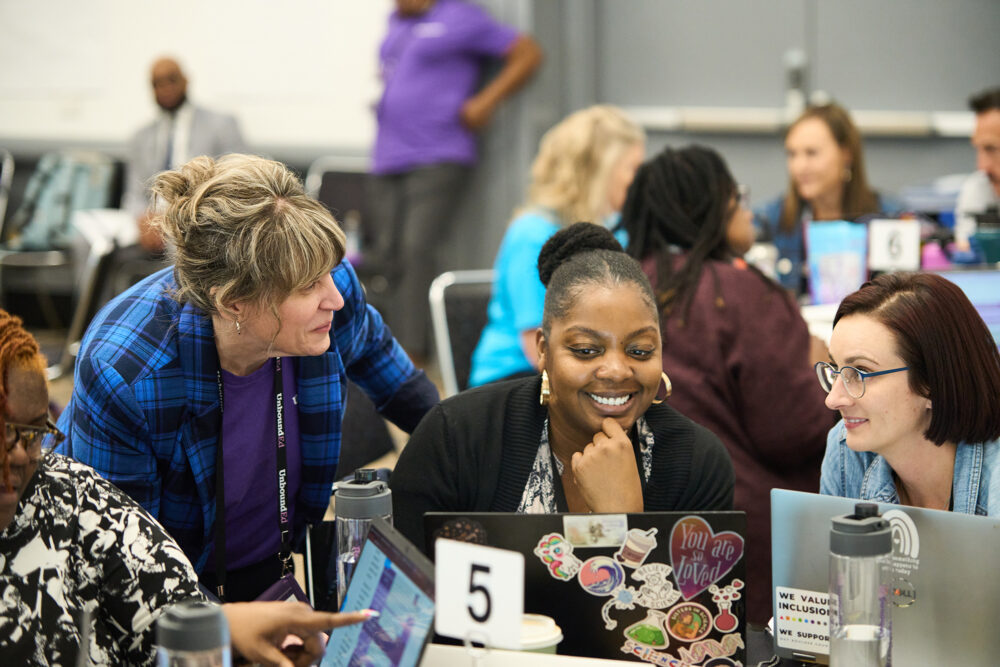
Have you been trying to affect change with math instruction in your building without getting results? Too often, we spend time on professional development, focusing on individual and isolated teaching strategies or practices. We hope these alone will change instruction and are disappointed when we don’t see improvement. That is because math instruction will not change unless the planning for math instruction changes.
Teachers need time to discuss and practice new strategies in a safe space with their peers. They need structures to plan for productive discourse and a clear path to implement new practices.
While the particulars of math Professional Learning Communities (PLCs) may vary within your building or district, having defined structures is crucial. Whether looking at formative assessment data or planning for an upcoming unit of study, a few essential conditions must be in place to ensure that your PLC has the structures to thrive.
Let’s examine three essential conditions that will give you the guidance and confidence to lead your math PLCs.
Condition #1: Ground your work in a shared vision of equitable math instruction.
Having a defined shared vision of what math instruction should look like in your building is important — it serves as the North Star that all instructional decisions should support. You must also include various groups of careholders in creating or refining this vision. Gather your math teachers and instructional leaders to ask them what equitable instruction looks, sounds, and feels like, and use their feedback to create a shared vision for your school or district. The work of your math PLCs should align with this vision.
Communicating this vision is equally important. Consider the following questions:
- How is this vision communicated and supported?
- How does each careholder contribute to the vision?
- How is the vision connected to the mindset and math identity of the care-holders in your building?
Condition #2: Establish clear structures for team, time, and tools.
Clearly defined structures are essential for successful math PLCs. It’s helpful to consider structures with regard to team, time, and tools.
When thinking about your PLC team, consider the following questions:
- Who attends the PLCs?
- What is their role in the PLC?
- How is their role aligned with the vision of quality math instruction?
- Are all team members clear on how they are contributing to the common vision? How do you know?
With regard to PLC time, plan your PLC structures with the following questions in mind:
- How much time is available for PLCs?
- Is pre-work expected? If so, how much time should participants spend on pre-work?
- How much planning time do teachers have daily? Weekly?
- How much of that planning time is collaborative?
- How is planning time protected?
Lastly, consider various tools used in your PLCs. Ask the following questions:
- What tools do we use in PLCs?
- Are the tools research-based?
- Do the tools serve as an anchor for conversations and support your common vision of equitable math instruction?
Condition #3: Define clear goals and expectations for your PLCs.
The last essential condition involves the goals and expectations of your PLCs. Goals and expectations are critical to a PLC’s success.
Consider the following questions regarding the goals and expectations of your PLCs:
- What is the goal of the PLC?
- Does the amount of time spent in PLCs support the goal?
- Do all participants understand the goal of the PLC? How do you know?
- How do team members work together in PLCs to support the common vision of math instruction? What norms will we establish?
- How do administrators and leaders support teachers in PLCs?
Ready to bring these conditions to life?
Work with your instructional leadership team members to answer the questions posed here. Are your answers aligned? Are there places where you need additional support or clarification? These questions are just the starting point. Continue to discuss your vision for equitable math instruction and the structures required to support that vision in your PLC.
Don’t miss out on the opportunity to revolutionize math instruction in your school! If you’re eager to learn how to establish powerful math Professional Learning Communities (PLCs) that transform teaching and learning, join us for our Math Leader Collaborative program. In this program, we support schools and districts in implementing the essential conditions of math PLCs. Together, we can ensure that every student excels in mathematics.
Next steps with GLEAM®
Choose the path that fits your team


UnboundEd Summits
Accelerate your instructional vision and build educators’ skills and expertise with a virtual or on-site Local Summit.
Learn More ➜

In-Service Workshops
UnboundEd’s dynamic, hands-on workshops build educator capacity by focusing on timeless, cross-disciplinary instructional moves that drive effective instruction, rigor, and student empowerment.
Learn More ➜
Online Math Academy
UnboundEd’s Online Math Academy courses enrich educators’ content knowledge and instructional practices to unlock all students’ math potential.
Learn More ➜
Curriculum Adoption
Ensuring quality materials are adopted and used effectively is crucial to improving outcomes and requires a strong instructional materials selection process. We’re here to share guidance and support on leading a rigorous and collaborative curriculum adoption process to select the right materials for your context and goals.
Learn More ➜
Curriculum Implementation
Just getting started, or need to get back on track? We work with you on a shared vision and an actionable plan for curriculum success.
Learn More ➜
Literacy ReclaimEd
Improve literacy instruction and better meet the unique needs of every student.
Learn More ➜
GLEAM® Inventory
Build your team’s understanding of grade-level, engaging, affirming, and meaningful –GLEAM®– instruction and transform how you serve all students in your district.
Learn More ➜
Speaking Engagements
Our experts offer inspiring, thought-provoking messages and conversations that will get your team thinking creatively about shifting mindsets and changing practice.
Learn More ➜
California Math Curriculum Adoption and Launch Cohort
Prepare to adopt and launch high-quality mathematics instructional materials with no-cost, grant-funded support from UnboundEd.
Learn More ➜